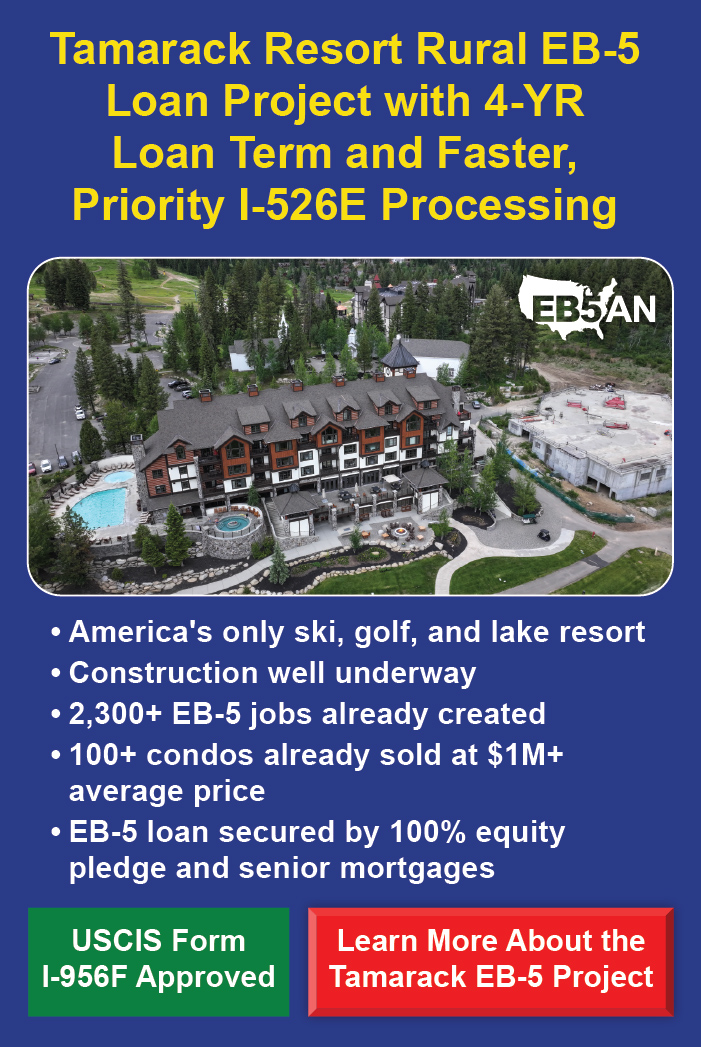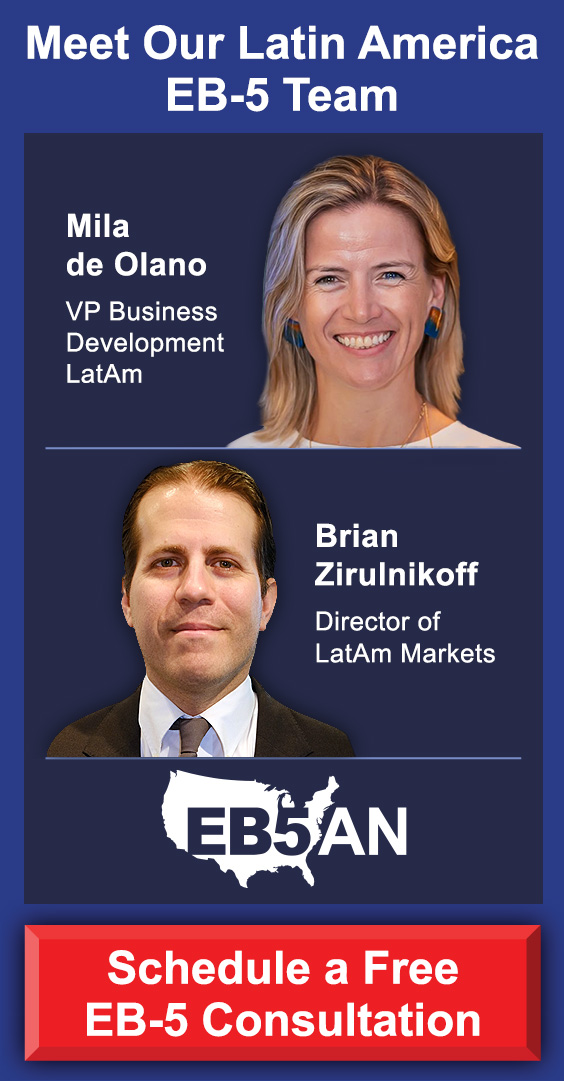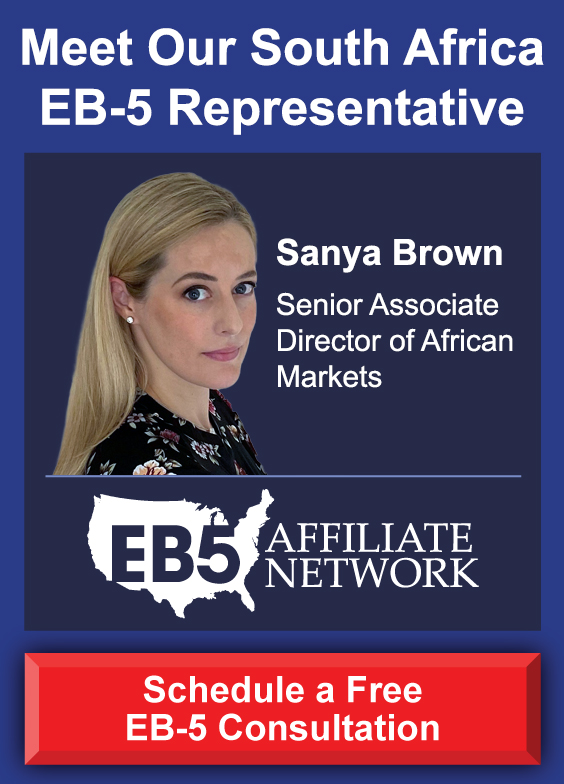
An EB-5 Investor visa is a Green Card option that is available to foreign nationals who are able to invest either $800,000 or $1,050,000 in a U.S. business project.
Typically, these projects are intended to create ten full time jobs for American citizens, with a special focus on rural targeted employment areas.
The first step in the process of applying for an EB-5 Investor visa, or EB-5 visa, is to file an I-526E petition. Once this petition has been approved, you are then eligible to apply for the Green Card.
If you are already in the U.S. on an immigrant visa, you will need to file Form I-485 to adjust your current immigrant status to that of a Green Card.
If you are outside of the U.S. and wish to invest in an EB-5 project, you will need to file Form DS-260 online and complete a process called consular processing in order to obtain your Green Card.
For both adjusting status and consular processing, you will need to attend an interview with USCIS.
In this article, we will explain this process so that you know what to expect.
What Is The Purpose Of The I-526E EB-5 Interview?
When Does The I-526E EB-5 Interview Take Place?
What Are Some Grounds For Inadmissibility That You Need To Be Aware Of?
How Familiar Do You Need To Be With The EB-5 Project For Your EB-5 Interview?
What Are The Documents That You Will Be Required To Take Along To Your EB-5 Interview?
What Is The Best Way To Prepare For The I-526E EB-5 Interview?
What Can You Expect After The I-526E EB-5 Interview?
Get Your EB-5 Investor Immigration Process Started with EB5AN Today!
What Is The Purpose Of The I-526E EB-5 Interview?
The main reason why USCIS requests an immigrant visa interview, is to review and verify supporting documents for the immigrant visa petition.
This interview will also ensure that you will not be subject to any grounds for inadmissibility.
Although the USCIS has already adjudicated the petition, the EB5 interview questions will include anything that the interviewer needs to know about your application.
The consular officer will usually focus on your general familiarity with the EB-5 project that you have chosen and your civil documents.
When Does The I-526E EB-5 Interview Take Place?
The I-526E interview will take place after an EB-5 investor’s I-526E petition has been approved and the investor files for conditional permanent resident status with the National Visa Center.
The EB-5 Investor and each family member applying for a conditional Green Card will be interviewed by USCIS.
Children under 14 years of age will not be asked to complete an interview with USCIS.
The I-526E interview is one of two interviews that occur during the EB-5 visa process, barring special circumstances.
The other interview to consider is the I-829 interview.
The I-526E interview is required for every single EB-5 visa applicant and their eligible family members.
The I-829 interview, however, is only required if USCIS deems it necessary to gather more biometric or personal information on an EB-5 Investor and their eligible family members, such as police clearance letters, a passport photo and so forth.
In either case, EB-5 applicants will be notified with an interview appointment letter of each scheduled interview.
Once the investor’s I-526E application has been reviewed by the National Visa Center, the investor and their family will be notified with an interview appointment letter of when they are to be interviewed and what documentation they will be required to bring.
The interview will take place at the U.S. consulate or embassy in the investor’s home country.
What Are Some Grounds For Inadmissibility That You Need To Be Aware Of?
If during the visa interview, you are found to be inadmissible, you will not be able to get your immigrant visa, or Green Card.
Your consular officer will check for any criminal violations, past unauthorized entry into the U.S., fraud and the misrepresentation of immigration facts.
Although inadmissibility can present problems, they are not always fatal. The most important consideration is to ensure that any possible grounds for inadmissibility are raised with your immigration attorney during the application process and prior to the immigrant visa interview.
How Familiar Do You Need To Be With The EB-5 Project For Your EB-5 Interview?
Consular officers will not re-adjudicate your immigrant visa application if the USCIS has already determined that you have invested money and satisfied the source of funds requirement.
A consular officer will however expect that you are familiar with the project that you have invested in.
Reviewing the business plan of the EB-5 project is absolutely essential and you should also obtain a comprehensive update of the current status of the EB-5 project.
Details that you will be expected to know include:
- The nature of the EB-5 project.
- How many jobs the EB-5 project has created/will create.
- The total EB-5 project amount.
- The total EB-5 project loan amount.
- What your investment funds are being used for.
EB-5 Investor Interview
Siddarth: EB-5 Investor
Siddarth, an Indian EB-5 Investor, spent a great deal of time researching the Twin Lakes Georgia project. Here is his advice for anyone who wants invest in an EB-5 project such as this.
What Are The Documents That You Will Be Required To Take Along To Your EB-5 Interview?
The I-526E interview is an immigration visa interview, designed to determine if you as an EB-5 applicant, are eligible for admission into the United States.
EB-5 investors and their eligible family members must review each of the documents they are required to bring to the interview to ensure all information is correct.
All interviewees should also be prepared to answer any questions related to their documents.
Documents that will be required of EB-5 investors and their eligible family members include:
- Valid passport.
- Color passport size photograph.
- Birth certificate.
- Marriage certificate.
- Copies of the Form DS-260 submission.
- Sealed medical examination results.
- Divorce decree.
- Police certificate.
It is important that you bring these as original documents to the interview.
In addition, passports should be valid at least six months into the future from your intended date of entry into the United States.
Other documents that will be required for the interview include:
- The cover letter for your I-526E petition.
- The business plan for the EB-5 Project.
- A copy of the I-526E petition that was filed.
- Bank statements or other proof (for example a letter from the bank) to show that funds were transferred out of escrow to the EB-5 project.
- Any information provided by the regional center project.
What Is The Best Way To Prepare For The I-526E EB-5 Interview?
A successful visa application process is not only dependent on having the right documentation. As an immigrant visa applicant, you will need to be well prepared for the interview process.
At this point in the I-526E EB-5 visa interview process, you should strongly consider seeking the help of a qualified EB-5 professional, who can help you and your family work through your immigrant visa applications and interviews.
At EB5AN, we are here to help you. Contact us for further guidance.
What Can You Expect After The I-526E EB-5 Interview?
Once you have completed your I-526E EB-5 Interview with the consular officer, all that you will need to do is wait for the final approval of your immigrant visa.
You will be notified of the approval, after which you will receive the actual visa.
Once you receive your visa, be sure to not open it. You will need to present the unopened, or sealed visa to the United States Customs and Border Protection upon your arrival into the United States.
Remember that if you present an opened envelope to the United States Customs and Border Protection, you could be denied entry into the United States.
Once you are in the United States, your Green Card and that of your family will be mailed to a U.S. address within 30 calendar days.
Get Your EB-5 Investor Immigration Process Started with EB5AN Today!
To ensure that your I-526E EB-5 interview is successful, it is highly beneficial for you to speak with experienced EB-5 immigration attorneys.
Not only will they help you identify a sustainable EB-5 project and help you through the entire investment process, but they will also help you prepare all the documentation that you need for your final interview.
If you would like to learn more about our available EB-5 projects, or are interested in taking advantage of our free consultation services, we look forward to hearing from you.








